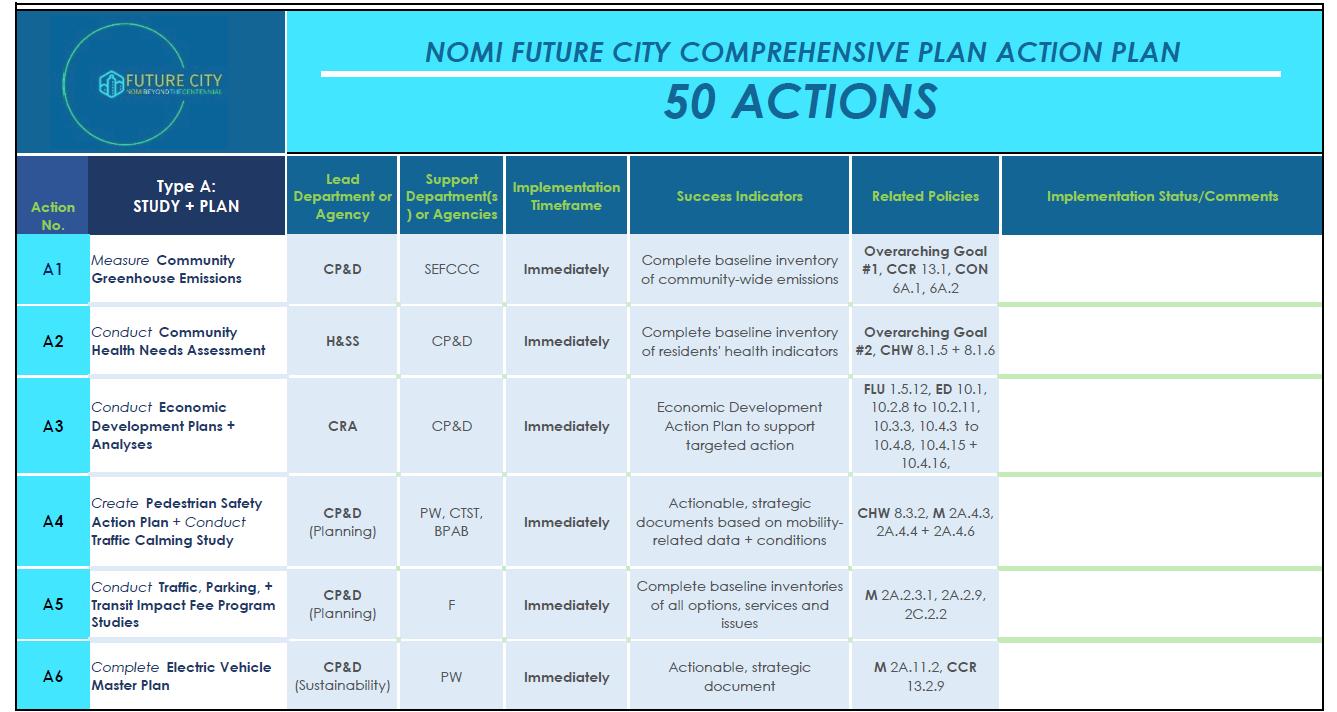BEYOND CLIMATE:
Local Resilience and the Comp Plan


























• 1800s: Town of Arch Creek.
• 1929: Incorporated as Town of Miami Shores.
• 1931: Renamed Town of North Miami.
• 1953: Reincorporated as a City of North Miami.
• Seventh largest city in Miami-Dade County.
• Home to Oleta State Park.

Population = 59,854 ()

Recent Rate of Growth = 0.1% ()
Median Age = 37.2 years ( )
Population 65+ years = 13.8% ()
Households = 20,214 ( )

Housing Units = 22,498 ( )
Family Size = 3.58 ()
Household Size = 2.87 ()
Homeownership Rate = 43.5% ()

Language other than English at Home = 76.5%
Households w/out a Computer = 3.8% ()
Households w/out an Internet Subscription = 23.3% () Disabled Population = 8.7% () Persons without Health Coverage = 21.1% ()








or Latino, percent(b)
alone, not Hispanic or Latino, percent Source: American Community Survey 2022 5-Yr Estimate

How can we take a more wholistic and systematic approach to updating the Comprehensive Plan?
What are the various components of the system and how do they interact with and depend on each other?
How do changes in one part affect other parts? What are the underlying assumptions and mental models guiding the current plan?
What are the problems or limitations in our existing systems that need to be addressed?
What are the critical issues and problems we should be tackling?
How do our residents think about growth?
What challenges within the system are affecting our community’s progress?
Are we considering the long-term effects and sustainability of our plan?
How will we measure success?
Are we open to new ideas and initiatives?

Housing affordability
Technology Infrastructure and Access


Community health and wellness

Environmental protection / Climate-change response


Steady Share (2.2%) of MDC Population
• Population = 68,867 | Increase = 8,692
• Households = 25,043 | Increase = 3,161
Moderate Growth (0.82% est. annual growth)
• Population = 74,255 | Increase = 13,380
• Households = 25,680 | Increase = 6,156
High / Assertive Growth (1.24% est. annual growth)
• Population = 81,705 | Increase = 20,830
• Households = 28,174 |Increase = 8,725

TPO projected population 2045
77,717

Projected increase: 16,842


Projected households 2045
26,799

Projected increase: 7,350


Systems-oriented: Organized and connected around the four priority topics
Actionable: Focused on implementation, with clear benchmarks and performance metrics
User -friendly: internally consistent, easy to navigate, with rich graphics Easy to understand: written in plain language
Accessible: provided in multiple languages, compliant with Americans with Disabilities Act standards and functional online



The Future City Comprehensive Plan seeks to honor North Miami’s past accomplishments while positioning the City to boldly steer its own future as a model for sustainable, resilient, equitable, innovative, functional, and enjoyable urban living within the region.


• In all policies, embrace and promote:
Equity and fairness
Sustainability and resilience
Technology and innovation
Community health and wellness
• Explore interconnections between these topics, connections to the plan elements, and understand how they impact each other.
• Embrace flexibility to create a policy framework that accommodates change

Warming Trend in North Miami:
Storm Severity - Rising Sea Level - Hotter Temps
Flood + storm surge risk to housing, businesses, institutions + public infrastructure
Health threats from longer, hotter summers
Stresses on the most economically + physically vulnerable
Warmer temps, subsidence + pollution degrade local ecosystem + natural assets



Residential property vulnerable to storm surge in a Cat. 3 to 5 hurricane: $2.1 billion





Neighborhood vulnerability to extreme heat

% of neighborhood below the poverty line





And what is community resilience?
In a resilient community, individuals and systems can survive, adapt and thrive in the face of chronic stresses and acute shocks and even transform when conditions require it.




• Self-organize
• Survive, thrive and adapt to chronic stresses and acute shocks

• Transform when needed


• Communities experience “wicked problems”
• Economic disparity
• Climate change
• Systemic racism
• Systems thinking is the best response to these cross-cutting issues
“WICKED PROBLEMS”
THINKING


• What is it and where did it come from?

• Systems thinking vs. linear thinking
• Organized vs. unorganized complexity
• How does systems thinking apply to urban planning?




• Holistic Perspective
• Improved Problem-Solving
• Enhanced Adaptability
• Stakeholder Engagement
• Long-Term Impact
• Strategic Alignment
























Land Use
Housing
Economic Dev
• Markets
• Jobs
• Technology
Schools

Development
Housing

Mobility
Infrastructure
•Hard and soft infrastructure
•Technology CIP









Conservation
Coastal Mgmt
Parks & Rec
Climate Change
• Hard and soft infrastructure
• Technology



• Reinforce/expand the City’s health infrastructure
• Always consider the impact of land use patterns, transportation systems, housing, the workplace, and the environment on community health
• Coordinate with the private health sector to help all residents achieve dignity, independence and positive health outcomes
• Develop safe, convenient, and pleasant public spaces for residents to gather and socialize
• Take a collaborative and civic engagementbased approach to community health decisions
• Use floodwater parks for urban agriculture to help reduce food deserts and promote access to healthy food
• Support development of health facilities integrated with a range of services and in proximity to residential areas.
• Allow co-location of senior housing, nursing homes, assisted living facilities and group homes for special needs population with health services
• Promote more and better walking and bicycle infrastructure and access to parks and recreation facilities.
• Introduce innovative housing concepts and housing arrangements, such as co-living to maximize residents’ ability to live independently

• Offer all residents equal opportunities to participate in decisionmaking that impacts their own health, safety, welfare, and general comfort

• New priority growth areas:
• PCD
• NMTSDO

• 20% of Floating Pool Units set aside for workforce and affordable housing
• Height flexibility/workforce and affordable housing density bonus for projects along the NW 7th Ave corridor PCD
• Emphasize resilience, community health and wellness, equity, green design and sustainability
• Expand range of allowed housing types and locations; emphasize workforce and affordable housing
• Prioritize livability and quality of design of the public realm
• Prioritize fairness in the delivery of services (and generally embraces the use of practices that support fairness and inclusion in design and development).
• Emphasize adequate infrastructure to accommodate future development
• Focus on technology-related and technologydriven land uses, businesses, and infrastructure
• Focus on improving public participation access in land development processes
• Update and expand home occupation policy to recognize shifting workplace conditions e.g., allow/encourage home occupations in mixed use developments; allow/encourage live/work units
• Enact stronger protections for residents from potential displacement as a result of redevelopment
• Adopt a Health Promotion Through Environmental Design (HPTED) principles to design the public realm
• Designate and implement "resilience hubs"
• Strengthen transitional standards for single family neighborhoods adjacent to a major corridor
• Improve design standards for retrofitting of existing strip shopping centers
• Strengthen protections for industrial lands
• Emphasize technology-driven uses in employment-oriented districts (incl. medical research)
• New policy section promoting Public Participation
• Equitably address housing needs of all income levels
• Promote high quality living/housing environments
• Expand allowed range of housing types and living arrangements, including ADU’s, co-living, live/work and compact units
• Embrace innovation and emerging technologies to support housing affordability and resilience (e.g., smart houses, 3D printing)
• Improve equitable access to transportation, employment, healthy environments and public facilities


• Commit to improving infrastructure to keep up with and provide for existing and future development
• Prioritize unaccounted water loss study leakage
• Prioritize funding allocation for water and sewer system improvements (5-year CIP and beyond)
• Implement Repetitive Loss (RL) Master Plan
• Implement Vulnerability Assessment
• Tightly control development approvals to ensure established LOS standards are met
• Invest in core internet infrastructure and next-generation technologies, digital literacy/education, and equitable technology access



• Achieve 50% reduction of greenhouse gas (GHG) emissions community-wide by 2030, 100% by 2050 (same as County target)
• Ensure that by 2030 all residents have support and resources available to avoid displacement, harm or danger from environmental shocks and stresses

Accurately represent projected flood/surge risk for shoreline development (Peril of Flood policies)
Develop resilient green infrastructure to help manage stormwater
Focus evacuation procedures on the needs of most vulnerable residents
Create resilience hubs
• Recognize the importance of parks in meeting social, cultural, educational, environmental, ecological, flood control and health needs to the community.
• Emphasize a high quality, interconnected, diverse, geographically balanced and accessible system of public parks and recreation sites, facilities and programming.
• Emphasize multimodality as part of improved accessibility to park sites
• Emphasize sustainability/green/resilient park planning and design


• Infrastructure to be in place to serve development
• Direct growth to where infrastructure is already adequate or where improvements have been prioritized
• Incorporate climate change and resilience considerations into capital improvement project criteria
• Prioritize funding capital improvement projects necessary to correct existing public facility deficiencies.






50 actions
5 Types of actions
Identifies responsibilities, collaborators, timeframes, measures of success, related policies (i.e., connections)
• A: Study + Plan - establish baselines for further action
• B: Shape the Future – model the regulatory environment
• C: Build Strong - create a resilient, sustainable, and equitable built environment.
• D: Improve + Excel - optimize City operations, practices and procedures
• E: Collaborate + Thrive - foster inclusion and participation of City stakeholders.





• Indicator tracking + Reporting = Accountability
• Linkage to processes:
Strategic Plan
Budgeting
Capital Improvement
Planning








• Start early
• Embrace complexity
• Be intentional
• Identify the problems that need solving
• Look for root causes
• Seek others’ help to map your system(s)
• Persevere!




• Tell a story/change the narrative (educate –emphasize – reiterate)
• Use simple, relatable language
• Involve both policy leaders and operational decision-makers
• Problem-solvers to facilitators
• Find (and maintain) project champions
• Establish a shared view of the system



• Consider the whole picture, rather than focusing on individual parts
• Look for connections and how components influence each other
• Keep zooming in and out at all times
• Beware of “analysis paralysis” (don’t get trapped in rabbit holes)
• Create boundaries and stopping points
• Consider unintended consequences



• Reframe problems to uncover new solutions
• View problems from multiple perspectives
• Pick the best solutions to experiment with
• Be open to, and prepared for, power-shifting
• Track changes over time
• Persevere!


Questions?
THANK YOU

Debbie Love, AICP Director, Development Services Dept.
City of North Miami dlove@northmiamifl.gov
Silvia Vargas, FAICP, LEED AP
Calvin, Giordano & Associates svargas@cgasolutions.com
Karla Ebenbach, AICP, LEED Green Associate Ebenbach Consulting LLC karla@ebenbach.com
